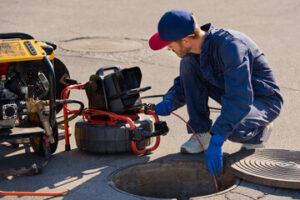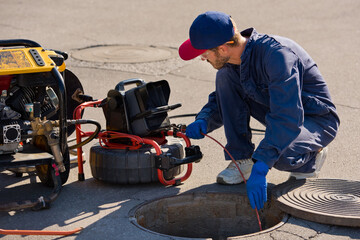Sewer Inspection Los Angeles can prevent future problems and costly repairs. They can also help determine responsibility for repairs, whether they fall within a homeowner’s property line or civic jurisdiction.
A camera can be inserted into a maintenance hole or a cleanout to evaluate the condition of large pipes. The inspection produces visual data that helps in determining pipe materials, locating defects, and identifying fittings and tees for repairs.
A zoom camera is an important part of a sewer inspection system. It allows the user to get a clear view of the pipe and helps them determine whether there are any issues that need to be addressed. It is also useful for identifying locations of obstructions or blockages within the pipe.
There are many different kinds of sewer cameras, and each one has its own advantages and disadvantages. It is important to do your research and find the best camera for your needs. Often, the best way to do this is to ask for recommendations from colleagues or friends in your industry. This will help you narrow down your options and make a decision that is right for you.
When choosing a sewer inspection camera, be sure to look at the specifications carefully. The camera’s sensor size and resolution are important factors. A smaller sensor will be able to offer more optical zoom, but may have trouble in low light conditions. It is also a good idea to check the camera’s pixel size, as this can impact the quality of the image.
The camera’s focal length should also be taken into account, as this will affect the amount of zoom that can be achieved. Ideally, the focal length should be listed in the camera’s specifications, typically in the format “35mm film equivalent: 28mm-280mm.”
A fixed zoom sewer inspection camera consists of a high-definition camera head attached to a pole that is lowered into manholes and surface entries at the point of access. The fixed camera heads have a powerful zoom and optimal lighting modules that allow for a rapid condition assessment of a pipeline network. Combined with a remote control, these systems enable the operator to locate and pinpoint any problems with the pipes. The camera data can then be used for preparing a plan to repair or replace the assets.
CCTV
CCTV stands for Closed Circuit Television Video, and it involves using a camera to inspect the inside of pipes or sewer lines. This technology makes it easier for plumbing professionals to identify the root cause of a problem and pinpoint its location. It also helps them to avoid expensive repairs that are based on guesswork and saves homeowners money.
In the past, plumbers used to use extreme and invasive methods to inspect drain lines and sewer pipes. They would have to dig up a lot of ground and remove walls, flooring, and appliances to get a clear view of the underlying conditions. However, modern technologies have made it much easier for them to do this job without damaging property.
A CCTV sewage inspection is a non-invasive and highly effective process that uses a waterproof camera to view the condition of a pipe. The plumber inserts the cable with the camera into a cleanout or access point above ground, and it slowly travels through the pipe. As it does so, the real-time footage is sent to a monitor above ground. It’s then analyzed by a plumbing professional who can see the exact cause of the problem, such as a broken pipe or clog.
While sewer line damage is often caused by tree roots, it can also happen due to a number of other reasons. A faulty line can easily break open and release toxic chemicals into the environment. Since the chemicals are denser than water, they sink to the bottom of the pipe and leak out through the damaged section. CCTV sewage inspections can help companies detect the source of the problem and take the necessary steps to prevent it from happening again in the future.
Sonar
The use of sonar in sewer inspection is a great way to identify the depth of sediment or debris in water lines. By combining it with CCTV, an operator can get the most accurate assessment possible of a pipe’s condition.
The specialized sonar equipment used for this purpose is mounted to a skid, float or robotic tractor that’s sent into the pipes. It creates a cross-section of the interior surface and measures the amount of sediment and debris that’s present, up to 20 feet or more in some cases.
This information is used to create a digital map of the pipe’s condition. It can be viewed in a CAD program or GIS platform and is used to help plan for maintenance activities, such as jetting or cleaning. It also helps system owners estimate the cost of repairing or replacing aging infrastructure, which is important when it comes to ensuring reliable service for citizens.
Unlike zoom cameras, which are limited by line of sight, sonar is capable of detecting a buried manhole or other connection and assessing the thickness of the pipe wall. It can also be used to locate bends, deflections in the line and even a change in elevation.
In the past, sewer inspection was done manually, requiring professionals to enter the confined spaces and visually check the lines for damage and blockages. This was a time-consuming process and posed significant risks to workers’ health and safety. The introduction of technology into this area has dramatically decreased the need for manual entry and made it much safer for staff to assess the state of the line.
Sewer systems are incredibly complex, and the condition of their internal structures is crucial for optimal performance. An investment in regular, detailed assessments can help ensure the long-term integrity of the infrastructure and keep service costs under control.
LIDAR
As a powerful tool for sewer inspection, LiDAR allows you to create 3D models of the environment. This information can then be used for analysis and design purposes. For example, it can help you determine where to place a new manhole or identify the condition of the pipe walls. This is also useful for identifying potential areas of obstructions or structural damage.
LiDAR works by shooting laser light at the surface of a structure and measuring the time it takes for the reflection to return to the sensor. This data is then analyzed to determine distance. LiDAR can also be used for determining surface conditions such as terrain elevations.
Typically, a human operator manually controls a tethered robotic inspection vehicle that is inserted from a well into a sewer pipe. This operator then annotates the CCTV-footage of the vehicle to record the condition of the pipe. This process is time-consuming and error-prone, especially for long pipelines.
A robot that can perform the same task automatically will enable operators to focus on other aspects of the job, thereby improving productivity and safety. In addition, a robot with this capability can provide more accurate and detailed information than CCTV, which is limited to the line of sight of the camera.
There is a growing interest in using 3D sensing technologies to improve the efficiency of robotic inspection systems. These sensors can be used to create a dense representation of the environment, which is necessary for navigation and localization in GNSS-denied environments. A number of different depth sensing techniques are available for this purpose, including monocular and stereo cameras. For example, the RealSense D400 family of cameras from Intel Corporation is widely used for indoor localization and mapping applications.
H2S Gas Sensor
Hydrogen Sulfide (H2S) is a colorless toxic gas with an odor like rotten eggs. It naturally occurs during the chemical breakdown of organic materials in the absence of oxygen. H2S can cause adverse health effects in concentrations of 10 ppm or less. It is also a flammable and explosive substance. For these reasons, it is critical to monitor H2S levels in confined spaces, such as manholes and other sewer systems.
A variety of conditions can lead to the formation of sulfide in a wastewater system. Transformation processes in the wastewater matrix and variable hydraulic conditions are known to play a significant role. Aside from these, the accumulation of sulfide in a system is also caused by specific events and control measures. It is therefore essential to evaluate the situation in detail with online H2S sensors and to implement appropriate actions based on the data.
The results of this evaluation showed that the online sensors exhibited very high sensitivity and correlation to the reference method. However, it should be emphasized that the sensor is sensitive to material accumulation at its installation point (tip), which may result in concentration spikes. Therefore, it is recommended that a local calibration of the sensor be carried out.
Since each of these tools has strengths and limitations, it is advisable to use them in combination in order to get a comprehensive picture of the condition of large sewers. For example, laser profiling can reveal buried manholes or other connections, while sonar can help assess pipe wall loss. In addition, combining them with CCTV and H2S detection allows the assessment to be performed more quickly.
It should be noted that a thorough assessment of the condition of large sewers can save thousands of dollars in the future by avoiding costly emergencies such as sewage overflows and pipe breaks. This is because detecting these problems early can help determine the most efficient ways to allocate limited resources for maintenance and repair work.
